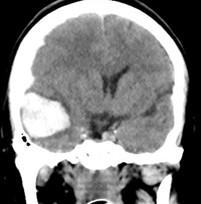Usted está aquí
Peruvian Journal of Neurosurgery
Intracerebral hematoma caused by Moyamoya disease: a case report
JOHN VARGAS URBINA, GIANCARLO SAAL Z., FERNANDO PALACIOS S.
Abstract (Spanish) ||
Full Text ||
PDF (Spanish) ||
PDF (English)
ABSTRACT
Introduction: Moyamoya disease is a chronic occlusive cerebrovascular disease of unknown etiology, characterized by bilateral stenotic and occlusive changes in the terminal portion of the internal carotid, as well as the presence of an abnormal vascular network at the base of the brain. The diagnosis is made with magnetic resonance (MRI) and digital subtraction angiography (DSA), SPECT is useful in the therapeutic decision. The surgical treatment of choice is revascularization.
Clinical Case: A 50-year-old female patient from China, with the Glasgow Coma Scale (GCS) of 9, and a clinical picture of stroke. An admission brain tomography (CT) revealed a right temporal hematoma. Surgical evacuation of the intracerebral hematoma was performed. Cerebral angiography revealed distal stenosis of the internal carotid artery and its branches, being diagnosed with Moyamoya disease. The evolution was favorable, neither a motor deficit nor a decreased level of consciousness (GCS:15) was observed at the time of discharge. A subsequent revascularization surgery was indicated.
Conclusion: Moyamoya disease is a rare cause of intracerebral hematoma but should be suspected in adults of Asian descent. MRI and angiography are the diagnostic methods of choice. Surgical treatment is revascularization, which improves the prognosis.
Keywords: Moyamoya Disease, Cerebral Hemorrhage, Stroke, Cerebral Angiography (Source: MeSH NLM)



